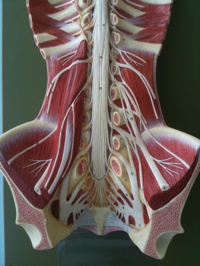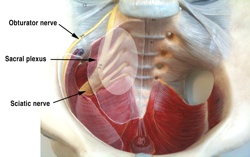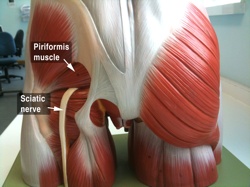
On Monday we started looking at the structure of the hip, the muscles there and the nerves involved in motor and sensory innervation. In my station we talked about the lumbosacral plexus. Lots of nerves!
A nerve plexus is merely a lot of separate nerves (it’s probably best to think of long, individual nerve cells) coming together into a group and then separating off towards different destinations. Some nerves from different spinal roots run off to those destinations together. It’s like cabling in a building. There are no connections between nerves in a plexus.
We said that the lumbar plexus + sacral plexus = lumbosacral plexus. You may read that the coccygeal plexus is involved too, and yes, the coccygeal nerve (the last pair of spinal nerves!) links with sacral nerves.
[Need to review the spinal cord? Check here (missing coccygeal nerve) and here].
The roots of the lumbar plexus are formed by spinal nerves L1-L4. Remember that the posterior rami pass to the back muscles, so the lumbar plexus is formed from anterior rami. The lumbar plexus lies deep to and within the psoas muscles, and the nerves will pass on to the lower limb and the lower part of the abdomen.

The main nerves of the lumbar plexus are the obturator nerve (from L2-L4, passes to the medial thigh), the femoral nerve (from L2-L4, passes to the anterior thigh), the ilioinguinal and iliohypogastric nerves (from L1, pass to the lower abdomen and groin), the genitofemoral nerve (from L1 and L2, passes to the cremaster muscle and skin of the scrotum, and also to the skin of the upper, medial thigh – it’s involved in the cremasteric reflex) and the lateral cutaneous nerve of the thigh (from L2-3, guess where it goes from the name!) I mentioned those in my teaching station, but they will also have been talked about in other parts of the anatomy teaching dealing with motor innervation to muscles that act on the hip and sensory innervation.
The nerves L4 and L5 come together to form the lumbosacral trunk. This links to the sacral plexus, joining the two plexuses and making it easier for us to take them together as the lumbosacral plexus.
The sacral plexus forms from the spinal nerves S1-S5 and lies upon the piriformis muscle. The major nerve from the sacral plexus is the pudendal nerve (S2-S4, main sensory nerve for external genitalia and motor to muscles of continence including the external urethral and anal sphincters and levator ani – these also receive other motor innervation though). The sacral plexus also forms many tiny, short nerves that directly innervate the muscles of the hip that the plexus lies on or near. As such these nerves may be difficult to identify but they exist; for example, the nerve to obturator internus (and gamellus superior) and the nerve to quadratus femoris (and gamellus inferior). Confusing? Sorry.

The nerves of the lumbosacral trunk are combined with the sacral plexus to form the sciatic nerve (L4-S3). This giant nerve running out through the greater sciatic foramen and into the gluteal region descends the length of the posterior lower limb, innervating the posterior compartment of the thigh and all the muscles distal to the knee. It splits into tibial and common fibular (or peroneal) nerves before it reaches the popliteal region behind the knee. This monster nerve, along with the superior gluteal nerve (L4-S1) and inferior gluteal nerve (L5-S2) is the reason why we consider the lumbar and sacral plexuses together. The number of spinal nerves contributing to the sciatic nerve (and the lumbar location of those roots) suggest that it is more likely to suffer impingement than any other nerves. I’m sure that most of you will be aware of sciatica. As the sciatic nerve passes into the gluteal region and is very large you must be aware of its location if you’re considering sticking needles into someone’s bum.
We didn’t talk about the parasympathetic nerves arising within the pelvis, so we’ll pick those up in other, pelvic-related weeks. The pudendal nerve also takes a very interesting route to reach its destination outside the pelvis, which we’ll also discuss in other sessions.
So, the lumbosacral plexus is formed from the anterior rami of spinal nerves L1-S5. The most important nerves to watch out for are probably those mentioned above, the lumbosacral trunk is the link, and the sciatic nerve (and gluteal nerves) is the main reason for the link. Make sure you can link these plexuses and nerves into your understanding of the abdomen, pelvis and lower limb.